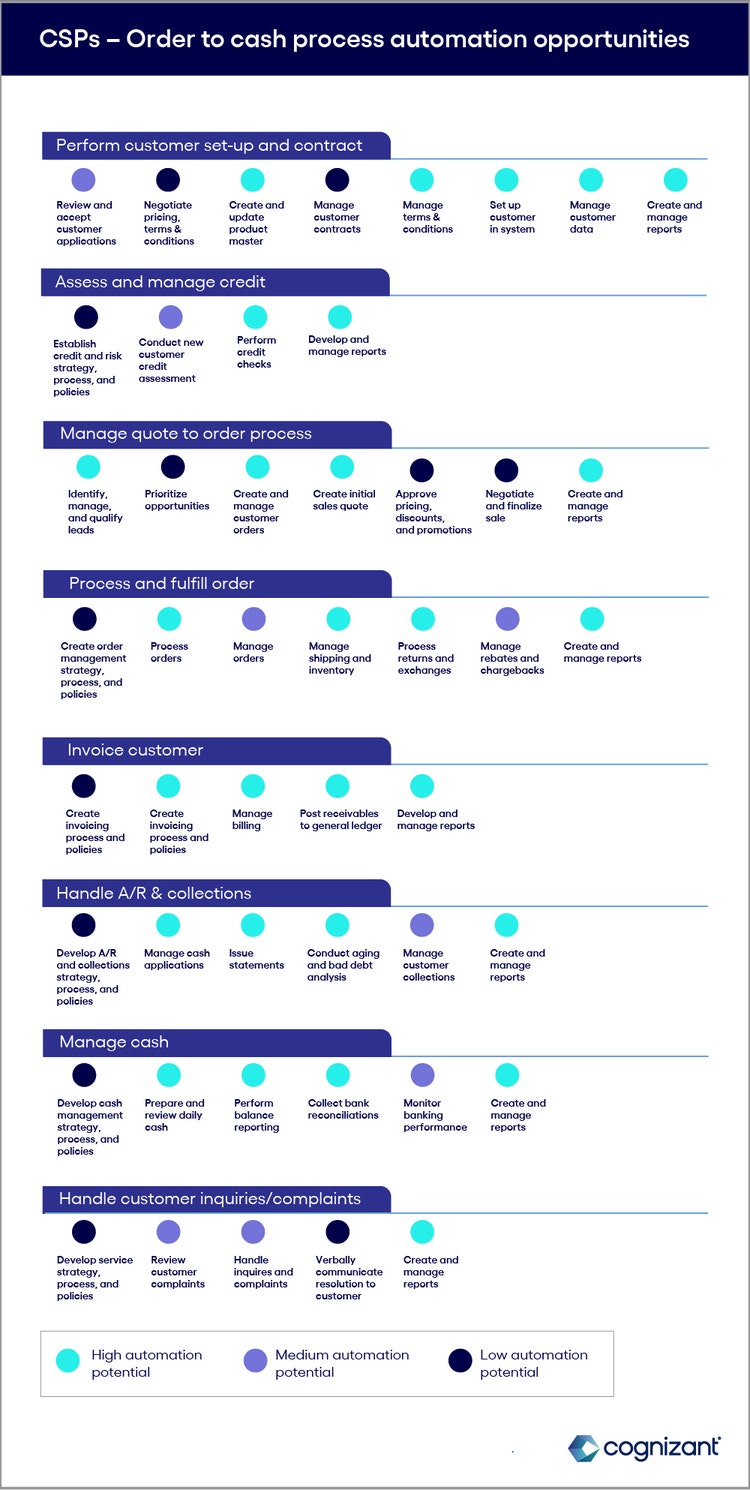
How CSPs can optimize costs to prepare for future growth
data-xy-axis-lg:null; data-xy-axis-md:null; data-xy-axis-sm:70% 0%
<p><br> September 11, 2023</p>
How CSPs can optimize costs to prepare for future growth
<p><b>Communications services providers (CSPs) are best served in their strategic cost reduction efforts by optimizing operating expenses through the judicious, proactive use of automation — rather than just cutting costs reactively.</b></p>
<p>Providers in the dynamic communications services face continual challenges and pressures. The rapid rise of 5G networks has greatly increased coverage and speed across all markets, making it extremely difficult for operators to differentiate in the face of this commodification of connectivity. While revenues have been rising, margins are eroding. In addition, experts are still predicting an impending global recession driven by high inflation and raised interest rates. These factors tend to push CSP leaders to prioritize cost-cutting and to revisit budgets. But such moves are usually reactive in nature and focused strictly on the short term. We have found the more strategic approach to be cost <i>optimization</i>, which is geared to medium- and long-term gains in efficiency and productivity and helps derive more from existing spends.</p> <p>While there are several ways to drive cost optimization, we will look closely at automation within service and network operations — the area where the most “bang for the buck” is available. Automating these operations is an increasingly potent differentiator as CSPs move beyond connectivity and become digital services providers too.</p> <h4>Operations is the logical cost optimization target<br> </h4> <p>A look at a few basic ratios helps show where to best focus optimization efforts. According to <a href="https://inform.tmforum.org/features-and-opinion/global-trends-in-telco-opex/" target="_blank">TMForum</a>, total expenses for CSPs amount to between 48% and 79% of revenues and a large proportion (around 60% to 90%) of capital expenditures (CapEx) is invested on the network. As customers demand ubiquitous connectivity, higher speeds and increased reliability, reducing investments in the network is not necessarily viable. Meanwhile, operating expenditures (OpEx) is 2.5 to 3 times higher than CapEx, offering far more scope to optimize costs. Key CSP OpEx categories include labor, network management and IT operations, intercarrier/wholesale payments, equipment, content, site/plant, energy, and selling, general and administrative expenses (SG&A). So, it’s a “target rich environment.”</p> <p>The high costs of CSP operations begs the questions: Can automation help optimize costs, and if so how and where? The answers depend on three factors:</p> <ul> <li>Are there repetitive processes that will continue to be applicable long term?<br> <br> </li> <li>Are there manual processes that can be readily generalized?<br> <br> </li> <li>Can substantial operational efficiency be derived from automated execution?</li> </ul> <p>As these questions make clear, service and network operations are the most logical and prime targets for automation.</p> <h4>Focusing on the automation potential in the order to cash process<br> </h4> <p>The CSP order to cash process, from customer signup and ordering of services through delivery of payments to the CSP, is often riddled with different teams, multiple systems and inefficient manual swivel-chair processes. CSPs have a significant opportunity to improve efficiency and lower the total cost of operations by automating ordering, fulfillment, service orchestration and revenue management. Figure 1 shows how many sub-steps in the order to cash process can be readily automated.</p>

#
<p><span class="small">Figure 1</span></p> <p>Pursuing such automation opportunities will help CSPs modernize service delivery and operations as they scale their 5G and FTTx offerings (fiber to the “x” (FTTx) refers to the use of fiber optics for the last mile of service delivery – to the building, to the home, etc.).</p> <h4>Automating network operations: Raise agility and speed while cutting costs<br> </h4> <p>In our 5G era, CSPs’ ability to launch new services quickly and cost-effectively will be crucial for their growth. Tasks involved include network planning and design, rollout, provisioning, assurance, operations and maintenance. But these processes are rarely seamless, and often require manual interventions. CSPs can reduce and optimize their costs by automating these processes and thereby position themselves for rapid service deployment.</p>
Key automation use cases in network operations
- Network deployment
- Operations and maintenance
- Fault detection and root cause analysis
- Self-optimization and self-healing
- Network lifecycle management
- Software-driven updates
- Continuous integration
- Continuous delivery
<p>According to <a href="https://www.cisco.com/c/dam/en/us/products/collateral/cloud-systems-management/network-services-orchestrator/acg-economic-benefits-of-network-automation.pdf" target="_blank" rel="noopener noreferrer">ACG Research</a>, network automation has the potential to increase business agility and speed and reduce operations costs by 10x. The extent of such automation depends on whether the CSP aspires to go beyond connectivity and become a digital services provider. It also depends on the CSP’s business and network strategies and its areas of operation. The different levels of automation range from manual operations and network maintenance at one end of the spectrum to a fully autonomous network at the other end.<br> </p> <p>Network automation is hardly new: Rules-based automation has been in place for years. In transitioning to autonomous networks, ML- and AI-supported automation that enables self-healing capabilities are instrumental.</p>
<p> </p> <h4>How CSPs can launch their cost optimization efforts<br> </h4> <p>Cost optimization efforts are not necessarily easy and come with their own sets of challenges and risks. They take considerable time to execute, disrupt CSP operations and thus impact productivity and staff levels, and often require new and different technologies and skillsets. In particular, automation efforts as we described above nearly always involve the cloud, AI and staff skilled in such technologies.</p> <p>Here are the five key steps which CSPs should take to kick off and ramp up cost optimization efforts:</p> <ol> <li><b>Define goals and set targets. </b>In determining cost optimization areas and objectives — a crucial first activity — CSPs need to keep in mind the potential business impacts optimization efforts will have and be sure they are not simply shifting spend without benefiting the organization.<br> <br> </li> <li><b>Conduct benchmark studies. </b>Such benchmarks will indicate which departments or lines of businesses fall short in comparison to industry peer averages, and even suggest solutions. For example, a CSP might find that the cost of its care operations is higher than that of its peers, suggesting the need to invest more in proactive maintenance that would reduce the CSP’s call-center volume.<br> <br> </li> <li><b>Design and implement solutions.</b> The implemented solutions may well benefit other facets of the business. Specifically, cost optimization via service and network automation can result in improved customer experience, faster time to revenue and higher margins of earnings before interest, taxes, depreciation and amortization (EBITDA — a KPI for CSPs and investors).<br> <br> </li> <li><b>Communicate.</b> With executive sponsorship presumably secured before optimization efforts were initiated, this step is to build consensus with business and functional leaders. This requires communicating what is to be done differently, why that is and “what’s in it for them.”<br> <br> </li> <li><b>Measure and improve. </b>Translating cost optimization outcomes into meaningful P&L metrics will determine their impact and identify further improvements. For example, service operations automation should result in improved customer experience, higher retention and greater revenue.</li> </ol> <p>Cost optimization should not be a one and done effort, but rather a perennial approach. It may take many months to years to see its full benefits, so ongoing business support is crucial. Applying this powerful method is not simple, and many CSPs intent on pursuing a cost optimization journey will identify and work with trusted partners that are familiar with the CSP sector, are adept in automation technology and share similar financial success models.</p> <p><i>To learn more, visit the </i><a href="https://www.cognizant.com/us/en/industries/cmt-solutions" target="_blank" rel="noopener noreferrer"><i>Communications, Media & Technology Solutions</i></a><i> section of our website or </i><a href="https://www.cognizant.com/us/en/industries/cmt-solutions#contact-us" target="_blank" rel="noopener noreferrer"><i>contact us</i></a><i>.</i></p> <p><i>This article was written by Ameet Sulibhavi Prahlad, Senior Manager in Cognizant’s Consulting practice.</i></p>
<p>We’re here to offer you practical and unique solutions to today’s most pressing technology challenges. Across industries and markets, get inspired today for success tomorrow.</p>
